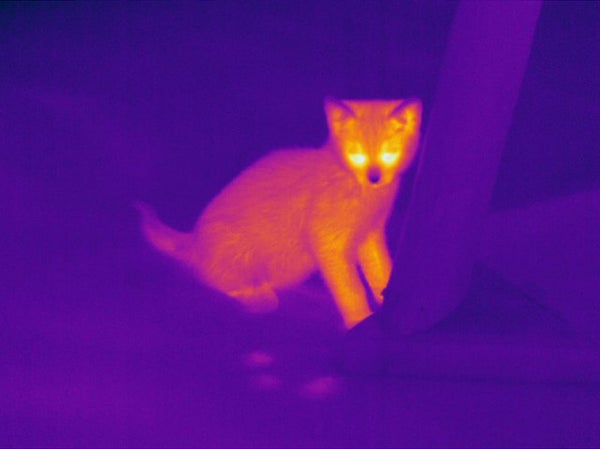Tired of having to reach for your night-vision goggles when you want to track someone’s heat signature after dark? Well, biotech may someday come to the rescue for all of you aspiring spies. Because researchers have developed an injectable, nanoscale antenna, which they’ve used to allow mice to see beyond their normal visual spectrum and into the infrared. The work appears in the journal Cell. [Yuqian Ma et al, Mammalian Near-Infrared Image Vision through Injectable and Self-Powered Retinal Nanoantennae]
Like all mammals, we humans are only able to see light in the visible spectrum, which includes all of the colors of the rainbow. That limitation is due to the photoreceptors in our eyes being only able to detect radiation with a wavelength of around 400 to 700 nanometers. Which means we can’t see infrared and near-infrared light, which has wavelengths a little bit longer.
And that got scientists thinking.
On supporting science journalism
If you're enjoying this article, consider supporting our award-winning journalism by subscribing. By purchasing a subscription you are helping to ensure the future of impactful stories about the discoveries and ideas shaping our world today.
“So we always curious on whether we can use any method or technique to allow us to be able to see near-infrared or infrared light.”
Tian Xue of the University of Science and Technology of China. He reached out to his colleague Gang Han at the University of Massachusetts Medical School, who engineered a teeny tiny device, which he calls an “up-conversion nanoparticle.”
[GH]: “We actually developed nanoparticles, so-called up-conversion nanoparticles, that actually can effectively be activated by this near-infrared light.”
Then they tested their system in mice. The nanoparticles attach themselves to photoreceptors in the animal’s retina. There, they absorb infrared radiation and convert it to visible green light.
[GH]: “This green light is absorbed by retinal cells.”
Which the brain then interprets as regular visible light.
This enhanced super-vision allows the animals to not only see in infrared, but to discriminate between different infrared patterns. So, for example, they could be taught to navigate toward horizontal stripes versus vertical ones—patterns that the researchers, themselves, couldn’t see.
Even Xue found that a bit disconcerting.
[TX]: “When we do the experiment sometime it feels a little bit creepy because if you do not wear night-vision goggles and when we do the testing we show the pattern to the animals, in fact to our own eyes we cannot tell any near-infrared patterns, but injected animal could. They can use patterns to guide their behaviors very accurately and efficiently.”
Han says the enhanced infrared detection did not appear to interfere with, or supersede, the animal’s standard-issue visual abilities.
[GH]: “The treated mice were able to perceive this light patterns in the daylight conditions, clearly suggesting that nanoparticles working in parallel with conventional visible vision as well.”
The technology, in addition to its applications in military or law enforcement, might even provide a possible fix for color blindness. And best of all, Xue notes, it wouldn’t need batteries.
[TX]: This new nanoparticle technique is stealthy and it do[es] not need external power. The nanoparticles directly activated by the infrared light itself.”
The nanoparticles remained active for as long as two months. A similar infrared boost could someday allow us humans to break through our natural visual limitations. And see things in a whole new light.
—Karen Hopkin
(The above text is a transcript of this podcast)

